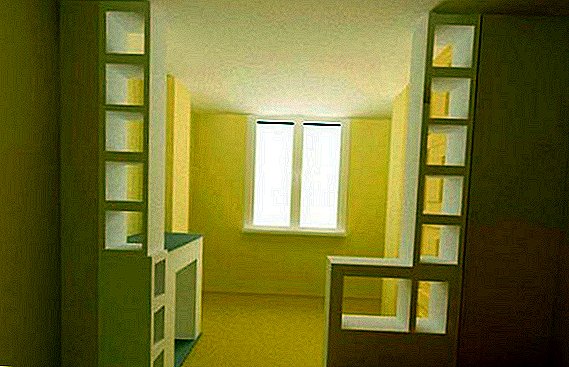 The invention of drywall has greatly simplified the process of building interior walls and relocations in the premises. Now in a short time and without large financial investments you can add an interior. Today we will explain in detail how to make a wall of plasterboard. Following the instructions, even a person who is far from construction will cope with this task.
The invention of drywall has greatly simplified the process of building interior walls and relocations in the premises. Now in a short time and without large financial investments you can add an interior. Today we will explain in detail how to make a wall of plasterboard. Following the instructions, even a person who is far from construction will cope with this task.
Preparatory stage
For a successful result requires proper preparation. It includes several stages.
Planning and design. Using the registration certificate of the premises, or making independent measurements, draw the changes you have planned. Take into account all the nuances of the room (for example, so that the wall does not become in the middle of the window), pay attention to where the electrical wiring in the room goes.
Important! When the sketch is ready, count the necessary materials: the number and type of profiles, how many sheets of plasterboard you need, and what type of fasteners will fit. Carry a sketch when you buy materials, then the consultants will help you choose the materials that match the final goal.

Make sure you have something to work with. For a standard wall with a doorway you will need:
- a screwdriver with a nozzle (its type depends on the type of fasteners) or a drill. In the second case, check the presence of a regulator of the force of tightening on the device, otherwise you risk damaging the drywall;
- construction level and plumb for installation. Perfectly replace this pair of laser self-leveling level, in addition, it will improve the quality of work and speed up the process;
- roulette at 5-10 m.
We recommend you read about how to remove the old paint from the walls, as well as how to properly glue the wallpaper of various kinds.
Preparation of the room. Mounting the wall is a dusty job, so the first thing to do is remove all movable property from the room where the repair is planned. If something cannot be removed, we cover it tightly with a film. We do the same with the surrounding walls.
Although if they are covered with washable wallpaper or paint, then you can leave them without shelter, but then be ready after repairing a couple of hours to devote to washing. When the room, tools and materials are ready, proceed to the first phase of installation. 
Fastening the top and bottom guide profiles
First of all we put the guides (marked as UW) profiles. Depending on the width of the desired substitution, in the stores you will be offered strips from 60 mm wide and more.
Their task is to designate the frame of the future wall:
- On the place where the planned construction, we outline the corresponding contour.
- Exactly on it we put the lower guide profile.
- Screw the profile to the floor (type of attachment is determined depending on the material of the floor).
Important! If the door is planned in the middle of a new wall, then the profile should be divided into two parts along the length: from the existing support to the beginning of the doorway, and then from the end of the doorway to the second support. If the door is displaced at one end of the stowage, then the solid profile is laid before the beginning of the doorway.
Video: how to properly fasten profiles for drywall
When the issue is closed with the foundation, you need to strengthen at the top. Here the scheme is simple:
- Determine the place for the profile on the ceiling. The easiest way to do this is with a laser level that accurately displays the desired line on a plane. Or we use for this a plumb: we lower it from the ceiling, setting points on it (the more, the more accurate the contour will be).
- Fix the profile to the ceiling. Take dowels or screws, depending on what material we crash into.
We advise you to read about how to insulate the window frames for the winter with your own hands.
Vertical and horizontal profiles
When guides are installed at the bottom and at the top, to complete the structure, it is necessary to put the frame vertically in order to close the perimeter.
Installation of vertical racks start from the side where you find it easier to work:
- To do this, in the lower profile, as in the support, we insert a strictly vertical guide profile.
- Between a design fastened with metal screws.
- At the other end of the switch, we also insert the rack in the same way.

Did you know? Drywall was patented as far back as 1894, but gained popularity only after World War II, when the world was in dire need of inexpensive facing material. True, at that time, it looked like its modern analogue a little in appearance and composition.
Further according to the plan - installation of the frame for the door:
- We put two pillars in the doorway, fixing them in the lower and upper rails.
- We check that the width of the structure from above and below coincides.
- Now we cut off a piece of the profile, the length of which is equal: the width of the future door + the width of the two posts to which we fix it.
- Mount the crossbar upside down.
- In the resulting hollow on the crossbar for structural strength, you can put a wooden beam. The same bars lay in vertical pillars to strengthen the door. Although if you plan to use enhanced profile models, such a precaution would be superfluous.
Learn how to make a waterfall with your own hands, a flower garden of wheel tires or stones, a wattle fence, a fountain, gabions, rock arias and a ladybug.
Video: mounting the frame for the door
Now, departing 60 cm from the future doorframe, we put vertical pillars along the entire wall, taking into account the width of the drywall sheets. If the rearrangement is planned to be over 3 m long, or later shelves, cabinets, etc. will be attached to it, then the frame should be reinforced with additional horizontal planks.
To a height of 2 meters, two such mounts will suffice at equal distances from each other.
Important! Keep in mind that any mounted elements will be fastened to such cross sections, because the drywall itself will not sustain such a load.
Electrical cable laying
After the frame comes turn posting. Profile manufacturers usually facilitate this task by making special holes in the metal for such purposes.
In accordance with safety rules, cables are placed in hidden networks (which include walls), in non-flammable boxes, corrugated pipes or non-flammable insulation (this is indicated by the "ng" mark on the cable).  The length of the box or corrugations is adjusted to the distance, which should be covered in the profile, but the cable with the need to take 30-40 cm more.
The length of the box or corrugations is adjusted to the distance, which should be covered in the profile, but the cable with the need to take 30-40 cm more.
According to the rules, the algorithm works as follows:
- First, pull the box or corrugation through the frame.
- Fix them in profile.
- Then a cable is inserted into the winding.
If you tighten the wiring you need to 1.5-2 meters, then do without the boxes and corrugations.
Working with cables, we remember that:
- for wiring requires its own scheme, in addition to the general design sketch. It is imperative to consider where the electricity will start from and at what points on the new wall to install sockets or switches;
- the cable route always lies smoothly, without sharp turns and right angles, otherwise the wires themselves will not enter the channel;
- We perform all electrical work by disconnecting the power to the network.
Video: laying electrical cables under drywall
Mounting sheets
Fix drywall simply: press the sheet to the profile and secure with screws.
But there are several technical nuances in this matter:
- Gypsum plasterboard (GCR) is attached to the profiles along the perimeter, edge to edge, i.e. the outer edges of the profile and sheet must match;
- while the second edge of the sheet can not "hang" in the air, it must fall on the profile;
- Because of these mounting features often have to cut drywall. For these purposes, you can take a knife on drywall or a regular stationery knife. On the sheet, make a markup on which you will cut. Carefully cut through the material along this line, and then turn over the layer, place a bar or any other object for elevation under the cut, and simply break off the desired piece. The thick layer of the sheet will succumb immediately, and on the layer of paper you will need to walk again with a knife;
- sheets are attached to the racks with self-tapping screws in 15-20 cm increments;
- Strengthening the wall with one hand, laying a ball of mineral wool or isover for sound insulation. How to fix it, it is better to check with a specialist during the selection of material for insulation;

Did you know? Sound insulation for the first time began to be used in ancient Egypt in the construction of religious buildings as one of the methods of influencing believers.
- installing sheets, do not forget to check them by level;
- a self-tapping screw is considered to be correctly twisted, which is only 1 mm recessed into drywall;
- do not forget also to align the cut edges, then it will be easier to mask the seams.
When installing sheets, keep in mind future sockets and switches. In the set with them special mounting boxes are sold, which help to install them.
- To begin with a crown in 55-56 mm we cut a hole in the wall. We pull out the corrugation with the cable through it and put the wires into the technological holes in the installation box.
- Then we insert the box into the hole and start tightening the spacer screws, which will fix it in the wall with the help of “wings”.
- Further it will be necessary only to put on the decorative part of the socket or the switch, but it is worth doing it after painting work. In the meantime, isolate the ends of the wires and proceed to the next step.
Video: the secrets of mounting drywall
Did you know? The ancient Greeks called the plaster "hypros"what means "boiling stone".
Seam sealing
We have joints of drywall sheets, as well as edging the doorway, which spoil the overall look of the structure. To disguise them, and level the surface for further decorative processing, you will need:
- putty mixture;
- scrim;
- putty knife.
- First, put a little putty to fill the junction of the sheets.
- After drying, you can glue the mesh, it should lie exactly in the middle so that there are sections of the same size on both sides of the seam.
- Apply another layer of putty over the mesh, and after drying, rub it with a float.
You will probably be interested to learn how to build a toilet, a cellar and a veranda, as well as how to make a brazier out of stone, a pergola, a gazebo, a fence made of gabions, a dry stream and a path made of wood cuts.

Important! The result of the manipulation will be a smooth surface, ready for any kind of decoration: painting (you will need 3 layers of putty), sticking wallpaper (2 layers) or applying decorative plaster (3 layers). Due to the quality base, the decor will fall well and last a long time.
Carefully follow the proposed instructions, do not forget to specify when working with specific brands of materials, and also make a competent sketch of the future construction (excellent, if you have an opportunity to evaluate it for an experienced builder), and then in a short time you will receive a quality switch with a door.
Network User Reviews















